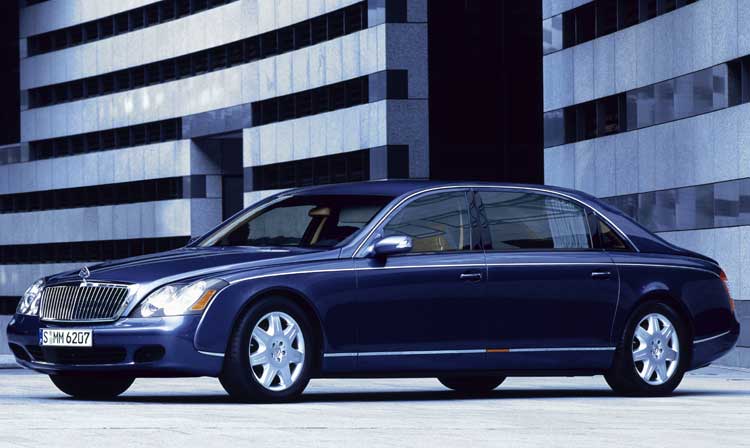Maybach
Why revive a car for grandees when they are extinct, asks Brian Sewell

It seemed an act of inspired lunacy, a year or two ago, for Mercedes-Benz to reinvent the Maybach. Most of us said, "The what?", for the marque was rare even in its brief heyday, and now, more than 60 years after the last car emerged from the factory at Friedrichshafen in 1941, it is pretty well forgotten here, and everywhere outside Germany. British auction houses keep alive the names of many manufacturers that would otherwise be lost to memory, but so few Maybachs survive that they rarely benefit even from that. Between 1921 and 1941, some 2,000 cars, at most, were produced, and of these, perhaps 135, hidden in barns, survived the Second World War.
It seemed an act of inspired lunacy, a year or two ago, for Mercedes-Benz to reinvent the Maybach. Most of us said, "The what?", for the marque was rare even in its brief heyday, and now, more than 60 years after the last car emerged from the factory at Friedrichshafen in 1941, it is pretty well forgotten here, and everywhere outside Germany. British auction houses keep alive the names of many manufacturers that would otherwise be lost to memory, but so few Maybachs survive that they rarely benefit even from that. Between 1921 and 1941, some 2,000 cars, at most, were produced, and of these, perhaps 135, hidden in barns, survived the Second World War.
They bear the name of Karl Wilhelm Maybach, the engineer of Royce integrity who designed, built and outlived their manufacture by two decades - he died in 1960 at the age of 81. He was the son of Wilhelm Maybach, friend of Count Zeppelin and Gottlieb Daimler, member of the board of Daimler-Benz, and a man with his finger in many engineering pies. From adolescence, Karl was steeped in the ambitions of men whose business was transport by car, train, airship and, eventually, plane and tank, and it was all but inevitable that he would seek to make the perfect car to rival Rolls-Royce and Hispano-Suiza. This he did, in spite of runaway inflation in Germany between the two world wars.
His very first car, the W3, was one of the most expensive to be unveiled at the Berlin Motor Show of 1921. As with Henry Royce, Karl Maybach made only the chassis - bodies were supplied by Kellner, Spohn and others. The engine, of 5.4l, was, like those of Rolls-Royce, unremarkable in design, but it was beautifully made and could, with reasonably light bodies, reach and hold the upper 70s. The transmission was of two-speed epicyclic design, the lower for starting and climbing hills, the higher for all other motoring, effectively dispensing with the need to change gear and tedious double declutching. In this, Maybach was in advance of other manufacturers. The chassis had the four-wheel brakes that were not introduced by Rolls-Royce until 1924.
So great was anti-German feeling after the First World War that the car had little chance beyond Germany, and only 700 had been made by the time production faded in 1929. In that year, the car that was the Maybach emerged. In its first incarnation, the DS had a 7l V-12 engine (hence DS for double six) that produced 150 bhp; swiftly developed, in its second, the following year, it became the DS7, the Maybach Zeppelin; in its final incarnation, its capacity 8l, its power 200 bhp at 3,200 rpm, the Zeppelin was given the ultimate clutchless gearbox - eight forward speeds changed by preselection and releasing the accelerator.
Eight out of 10 of them were bodied by Spohn, and this was very much in the idiom of 1930, with sweeping wings and wide running-boards framing a high box for passengers, the huge hood folding back on to a small boot; spare wheels slotted into the front wings and sprung steel bumpers were either wide and plain in the English manner, or narrower bands paired, in the American. Its line, when open, was clean and functional; when closed it could pass for a saloon. It appealed only to the very rich and very conservative, to whom it sold at a rate of 25 a year, at best, less than 250 in all.
It was into the heritage of this Zeppelin that Mercedes-Benz sought to tap when they conjured the current Maybach out of their hat to rival the VW-Bentley and BMW-Rolls - Karl Maybach had been an M-B apprentice, they argued, and they had bought what was left of the firm after the Second World War. In engineering terms, it is as good as these, but in looks it echoes not the sober grandeur of Maybach's Maybachs but seems something aired by Invicta's Black Prince saloon of 1947 from Rover's now-too-familiar 75. This stylistic hybrid is not conservative enough to make the point made by the Spohn's great cabriolets of the Thirties - that Maybach was the marque for a man of antique taste, who had a Canova in his hall and Casper David Friedrich landscapes hanging in his Biedermeier salon. Such grandees no longer exist, and without them, a great car so much the personal creation of a great engineer should not have been revived; like Bugatti, it should have been allowed to slip into the waters of oblivion.
Join our commenting forum
Join thought-provoking conversations, follow other Independent readers and see their replies
Comments
Bookmark popover
Removed from bookmarks